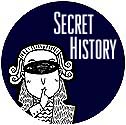
Comment
on this story |
 |

Commemorations of the strange life of John Mitchel
by Jack Neely
As the young bearded man and his companion rode into the Tasmanian wilderness, the policeman shouted, "Stop! In the Queen's name!" The villagers watched. Some smiled, and others grinned. They had no intention to interfere. Down the road, in the deep woods, the two men swapped coats and horses, and split up.
Passing himself off as a priest, he rode for days until he reached Hobart Town, where there was a small sailing ship, a passenger brig called the Emma, waiting. The ship was crawling with red-uniformed British authorities. That night, by moonlight, a rowboat eased up to the Emma. The bearded man climbed aboard. The captain greeted him.
"You were almost too late, Mr. Wright," he said.
His name was not Wright, and the captain knew that. He was, that evening, the most wanted man in Tasmania. He did not know it at the time, but he was bound, in a roundabout way, for Knoxville, Tennessee.
The famous journalist and Irish revolutionary, a leader of the notorious Young Irelanders, had just escaped a penal-colony sentence for treason against the crown. After advocated guerrilla action, including attacks on British railways, he'd spent the last few years on the island then known as Van Diemen's Land. His two-month odyssey of escape began 150 years ago this Sunday.
He rode the Emma north to Sydney, where he slipped off and, still disguised, embarked on the Orkney Lass by way of Tahiti to Honolulu. Only there, under the Stars and Stripes, could John Mitchel let his guard down and use his real name. His wife and children met him in Honolulu, and they sailed together to San Francisco. From there he sailed to New York. But then, a year and a half after his arrival in America, he came to Knoxville.
"Why I should go to Knoxville, Tennessee," he wrote: "of all places in the whole world, and bring my wife and children with me; especially as I had never seen Knoxville, did not know one human being at Knoxville, might seem a question difficult to answer upon grounds which would be allowed as rational."
Many have felt the same way. There were other aspects of Mitchel's personality that were not altogether rational. He astonished some of his Irish allies when, upon arriving in America, he became a secessionist. He somehow developed the theory that abolitionism was another Anglo-Saxon conspiracy against the Celts, and that the Celtic South was "the Ireland of this continent."
He first stayed in the Coleman House on Gay Street (before it was known as the Lamar House), but later established a farm in Tuckaleechee Cove, near modern-day Townsend. After a couple of seasons of attempted farming, he moved back to Knoxville in 1856 and bought 12 acres on First Creek—perhaps in the vicinity of what would later be Caswell Park—and built a large house. He lived there while he edited a memorable secessionist weekly called The Southern Citizen, with William Swan, prominent local attorney and co-donor of the new public plaza called Market Square.
In Knoxville Mitchel was known, loved, and hated. During the brief Know-Nothing period of America's greatest phobia of foreigners, Mitchel was unapologetically Irish. His boasts that the Irish were not only equal to native-born Americans, but superior to them, didn't sit well with some. He and Parson W.G. Brownlow, Knoxville's most notorious Know-Nothing, especially disliked each other. Mitchel called Brownlow "systematically, chronically frantic in his personal abuse of all and sundry...ready to gouge any fellow creature at a moment's notice." In 1857, John Fleming, the xenophobic editor of the Knoxville Register, challenged Mitchel to a duel; unfortunately, it was broken up by the local authorities.
Mitchel left in late 1858 to further his journalistic career in Washington. The war didn't treat him well; two of his beloved sons died wearing Confederate uniforms, one of them in Pickett's Charge. After imprisonment for his own pro-Confederate activities, Mitchel returned to Ireland a hero.
Here, in the tides of war and reconstruction, Mitchel was almost completely forgotten. When he died in Ireland in 1875, weeks after being elected to represent County Tipperary in Parliament, the former Knoxvillian got only a small mention in the local papers. His Knoxville home vanished without notice.
It's a very different story in the place from which he escaped, Bothwell, Tasmania, which is currently celebrating his short time there. A few months ago, I heard from Greg Ramsay, of Bothwell, who'd found one of my stories on the web. He's a young scholar and preservationist who is, among other things, involved in renovating Australia's oldest golf course. He filled me in on their Mitchel commemorations: they have a fine website celebrating Mitchel's strange life, at www.johnmitchel.net. A planned book of essays about Mitchel, with contributions from Irish, Canadian, Australian, and American scholars, will support the preservation of a low, cream-colored masonry house on a Tasmania farm. It was John Mitchel's own cottage, the one where he and his family lived before his escape. It's still standing, but in need of some repair. Ramsay has hopes of turning it into a museum to celebrate the man who, however involuntarily, was one of Bothwell's most famous residents.
If you're planning a Tasmanian adventure this summer, you might want to drop in and say howdy.

June 5, 2003 * Vol. 13, No. 23
© 2003 Metro Pulse
|





